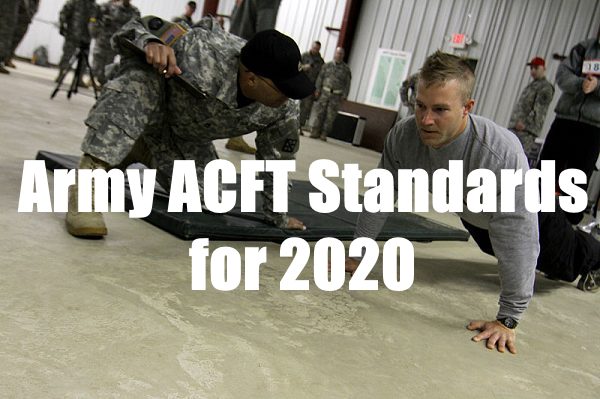The Army recently updated its Army Combat Fitness Test (ACFT) to better evaluate if a soldier is physically combat-ready.
Physical fitness is critical in the Army.
First, physical fitness has obvious physical benefits.
Also, fitness has psychological benefits, including reducing stress, illness, and the chances of injuries.
Plus, fitness is necessary to ensure soldiers are prepared for their mission.
The Army created a new combat-focused physical fitness test that tests five domains of physical fitness.
These domains include muscular strength, power, cardiorespiratory endurance, and speed/agility.
There are six events to the Army Combat Fitness Test, which we will look at in detail.
Related Article – Army Uniform Regulations
ACFT: What Changed and Why?
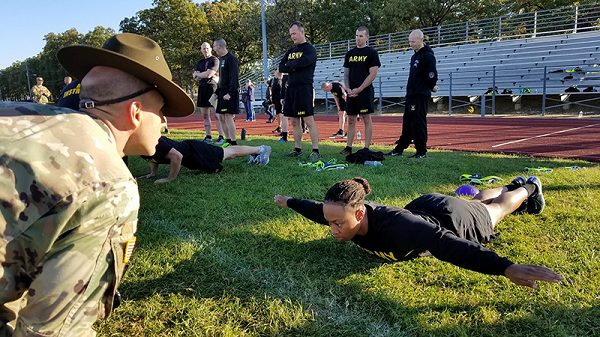
Before the change to the ACFT, the Army had used the same fitness test since the 1980s.
The new Army Combat Fitness Test has a design capable of providing a better assessment of a soldier’s capability to perform while in combat.
The fitness test is very rigorous, strengthening and conditioning soldiers in a way that represents the movements one will need in combat.
Originally designed to be both age- and gender-neutral, changes for 2023 take age and gender into account for scoring.
Six Different Events for ACFT
There are six different events for the Army Combat Fitness Test.
Each event has an expectation and a proper technique.
- Maximum Deadlift
- Standing Power Throw
- Hand Release Pushups
- Sprint/Drag/Carry
- Plank
- Two-Mile Run
Event #1: Maximum Deadlift (MDL)
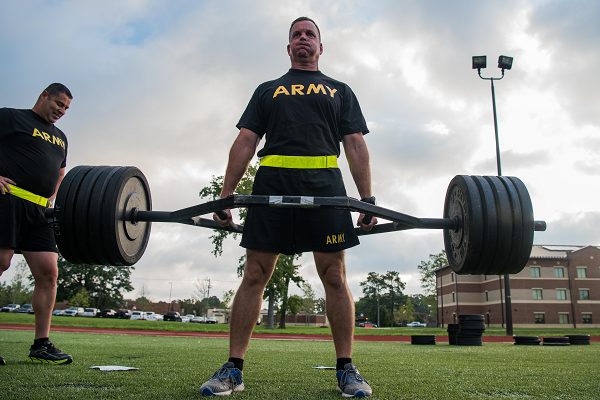
The deadlift shows a soldier’s ability to lift heavy items such as carrying a casualty or carrying heavy equipment.
How to Perform
With the deadlift, you would step inside the trap bar and place your feet shoulder-width apart.
Bending at the knees and hips, you grab the handles with your arms extended, your back flat, and your head in line with your spine.
When told to, you will stand and lift the bar by straightening your legs and hips.
However, your back must stay straight.
Also, you must perform this movement three times with the same weight.
This video will give you visual support of how this should look:
Points earned are based on gender and age. Male soldiers earn 60 points for 140 pounds at any age, and female soldiers earn 60 points for 120 pounds.
The max 100 points are awarded to men ages 17 to 46 for 340 pounds.
Women 17 to 21 earn 100 points for 210 pounds. At ages 22 to 36, women must deadlift 230 pounds to earn 100 points. Between the ages of 37 to 46, women must again lift 210 pounds to earn 100 points. The weight requirement drops to 190 until age 56, and then to 170 for women over the age of 57.
Getting Ready
If you worry your fitness level needs some work to be successful at the deadlift, some exercises can help get you ready.
Consider starting with alternating squat jumps.
Also, when you are ready to add weights, you can perform forward lunges with kettlebells.
Related Article – Air Force PT Test Standards
Event #2: Standing Power Throw (SPT)
The Standing Power Throw demonstrates a soldier’s ability to use explosive power when moving or handling equipment.
For instance, if you must throw equipment or jump across an obstacle, you need explosive power.
How to Perform
To perform this movement for the ACFT, you will hold a 10-pound medicine ball and throw it up and behind you.
You can flex the trunk of your body as well as your knees and hips when lowering the ball.
For a visual of what this should look like, you can see this video:
Scoring
The Standing Power Throw is scored based on your gender and age. For men ages 17 to 21, 60 points are awarded at 6.0 meters. The full 100 points are awarded at 12.6 meters.
Male soldiers between the ages of 22 to 26 earn 60 points for 6.3 meters and 100 points at 13 meters.
Those between 27 to 36 need to throw 6.5 meters to earn 60 points and 13.1 to earn 100. The distance requirements then begin to narrow after age 37.
Women aged 17 to 21 must throw 3.9 meters to make 60 points and 8.4 to earn the maximum 100 points. Female soldiers aged 22 to 26 score 60 at 4.0 meters and 100 points at 8.5.
Female soldiers between the ages of 27 and 31 must throw 4.2 meters for 60 points and 8.7 for the full 100. The distance requirement begins to drop after age 32.
Two of your attempts are recorded; however, the longest of the two is your score.
Getting Ready
You can prepare for this part of the fitness test by practicing a power jump without weights.
Also, the tuck jump helps develop explosive power.
Furthermore, the overhead push press using kettlebells for weights helps develop the upper body strength you will need to be successful with the Power Throw.
Related Article – Marine Initial Strength Test (IST) Standards
Event #3: Hand Release Pushups (HRP)
This event tests upper body strength and endurance, proving a soldier can perform repetitive tasks in combat.
These repetitive tasks include pushing objects or people out of your way and getting up and down from the ground quickly.
How to Perform
You will lay prone with hands flat on the ground.
Also, your index finger should be just inside the edges of your shoulders.
Furthermore, your chest and the front of the hips and thighs are on the ground at this point, as well.
Feet are together, and your ankles flexed.
When told to, you will push your body up in a smooth motion by straightening your arms.
Your goal is to keep your body in a straight line from head to ankles.
The second part of this movement is to bend your elbows to lower yourself back to the ground, so your chest and hips reach the ground at the same time.
For the third movement, you will briefly move your arms out straight to the sides to create a T-shape.
After, you return to the starting position with hands under your shoulders.
This video gives you a demonstration of what the Army expects with this movement.
This is a timed event, so you need to complete as many as you can while maintaining good posture for two minutes.
Scoring
Soldiers of all genders and ages earn 60 points for 10 repetitions. To receive the maximum 100 points, men aged 17 to 21 must perform 57 reps, while women in this age group must do 53.
Rep requirements for the maximum score for men increase as they age, with 61 required for men aged 22 to 26, and 62 reps for those aged 27 to 31. Rep requirements then begin to drop after age 32.
For female soldiers over the age of 22, the requirement for the maximum score begins to drop immediately. Only 50 reps are required to score 100 points for those aged 22 to 26. At ages 27 to 31, you’ll need to perform 48 reps to score 100 points. The requirement continues to drop thereafter.
Getting Ready
If you struggle with the pushup portion of the ACFT, you can begin to prepare by using an incline bench with a barbell and by including chest presses with dumbbells.
Also, begin doing as many pushups as you can until you reach your goal.
Related Article – 9 Army Basic Training Graduation Gift Ideas
Event #4: Sprint/Drag/Carry (SDC)
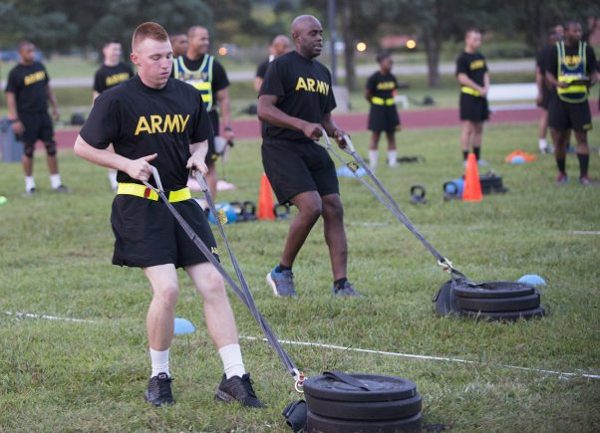
This event tests your capacity to complete intensive tasks during combat, such as reacting quickly when necessary, carrying casualties, or carrying ammunition, just to name a few.
How to Perform
You begin in a prone position, and when you hear the command, you stand and sprint for 25 meters and then come back.
Next, you grab a handle of a weighted sled, and you pull the sled backward for 25 meters before turning and pulling it back to the start line.
The next move in this event is the performance of a lateral from the start line to the 25-meter line and back again.
A lateral is a quick side shuffle movement.
The next movement in this exercise is the carry.
The solder will take the two 40-pound kettlebells from the start line and run the 25 meters and back again.
Scoring
Men aged 17 to 21 earn 60 points for completing the SDC in 2:28 minutes and women of the same age for completing it in 3:15. The max 100 points are earned by completing it in 1:29 and 1:55, respectively.
The time requirements for points drop slightly for older men and women. From ages 22 to 26, 60 points are awarded for time hacks of 2:31 and 3:15, respectively. The max 100 points require time hacks of 1:30 and 1:55.
Time requirements points continue to lower for those over the age of 27.
Getting Ready
This event requires the use of many muscle groups, so your training should, as well.
Also, much of the work you do to prepare yourself for other events lends to preparation for the SDC.
Deadlifts and bent-over rows are essential for the SDC.
Also, shuttle runs with increasing distances are helpful.
Event #5: Plank
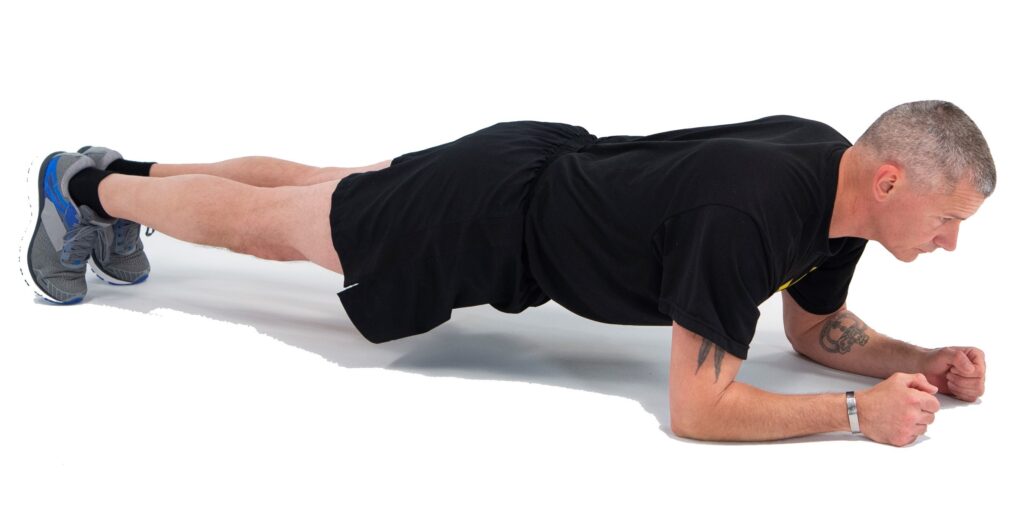
The plank tests a soldier’s core strength and endurance, along with their balance.
When these muscles are strong, there is less likelihood of injury when climbing walls and other obstacles.
How to Perform
You begin by lying on the ground with your hands in fists or flat and no more than a fist’s length apart. You’ll start with your forearms, hips, and toes on the ground.
To perform the movement, on the command, you’ll lift your knees and hips off the ground in a straight line with your shoulders.
You’ll need to maintain a straight-line position from your head to heels, with no part of your body touching the ground except for your toe, forearms, or hands.
This event is timed, and you’ll be scored on how long you can hold this position in the proper alignment.
This video demonstrates the proper technique for the Plank.
Scoring
Both male and female soldiers earn 60 points by holding the plank position for 1:30 minutes. Soldiers aged 22 to 26 earn 60 points by holding it for 1:25 minutes.
The time requirement drops by 5 seconds for each age group up to age 37. At this point, all soldiers must earn their minimum score of 60 for the plank by holding it for 1:10.
To score the maximum of 100 points, both men and women aged 17 to 21 must hold the plank pose for 3:40 minutes.
Similarly, the time to earn max points drops by 5 seconds for each age group until the age of 36. After age 37, all soldiers must hold a plank for 3:20 to score 100 points.
Getting Ready
Core strength is vital for the Plank.
To best prepare for the Plank test, add bent leg raises and leg tuck and twist movements to your routine.
Also, side bridges will strengthen your core muscles.
Event #6: Two-Mile Run
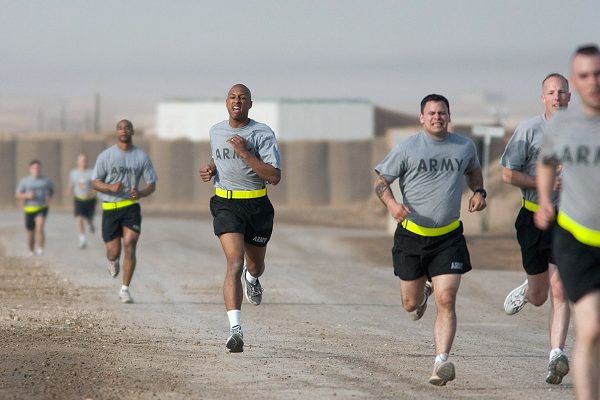
The two-mile run is a standard on a fitness test, and it is one event that carried over from the old test.
The run measures aerobic endurance, which is needed for physically challenging tasks while in combat.
How to Perform
The run can occur either inside or on an outside track.
However, it cannot be held on rough terrain.
Scoring
Men aged 17 to 36 who complete the run in 22 minutes earn 60 points. Women aged 17 to 21 must complete the run in 23:22 to earn 60 points. Thereafter, the minimum time for women over 22 varies between 23 to 25 minutes, depending on their age group.
To score the max 100 points on this event, male soldiers aged 17 to 21 must complete the 2 miles in under 13:22, and female soldiers under 15:29.
The minimum time requirements to earn the max score on the 2-mile run rise slightly for men over 22 by a few seconds per age group.
Oddly, women between 22 and 31 must run the 2 miles in less time than younger female soldiers. To receive the max 100 points, they must run the 2 miles in under 15:00. After 32, the time allowed rises incrementally.
You can download more detailed information about ACFT from the Army.mil website.
Getting Ready
Getting prepared for the two-mile run requires taking the time to build up endurance for sustained running.
To avoid injuries, be sure your running program works in gradual increments.
Related Article – Acing The Army 2 Mile Run in 3 Easy Steps
Frequently Asked Questions (FAQ)
Is the ACFT harder than the APFT?
Technically speaking, yes.
In the past, the APFT would simply test how many push-ups and sit-ups you could do, followed by a 2-mile run.
The ACFT is much more involved and is a big improvement over the archaic design of the APFT.
By design, the ACFT involves much more physical work, especially in your core and leg strength areas.
This is critical to determining the fitness level of future Army soldiers, both from a physical aspect, as well as a mental one.
When did the ACFT replace the APFT?
The ACFT replaced the APFT as the primary physical fitness test for the US Army as of October 1, 2020.
The scoring requirements were adjusted to age and gender differentials in March 2022.
Will the ACFT standards be based on MOS?
Yes. The standards will be set at 3 levels:
1. Gold: Moderate MOS physical demands.
2. Grey: Significant MOS physical demands
3. Black: Heavy MOS physical demands
In order to successfully graduate from Basic Combat Training (BCT), Advanced Individual Training (AIT), Basic Officer and Warrant Officer Basic Leadership courses, and One Station Unit training, you will need to achieve a standard of Gold.
Conclusion
The Army revamped its fitness test to include movements a soldier needs to make in combat.
All of the events require the use of multiple muscle groups at one time.
There are six events for the Army Combat Fitness Test (ACFT) including the deadlift, standing power throw, pushups, the sprint/drag/carry, plank, and running.
Each event is scored individually, and there are ways to prepare for the fitness test to ensure success and to avoid injuries.
References:
https://www.army.mil/e2/downloads/rv7/acft/fy20_standards.pdf
YouTube
- Replacing Dog Tags: 6 Things You Need to Know - June 28, 2024
- Navy OAR Test Study Guide - June 24, 2024
- 10 Best Sniper Movies of all Time - June 20, 2024

